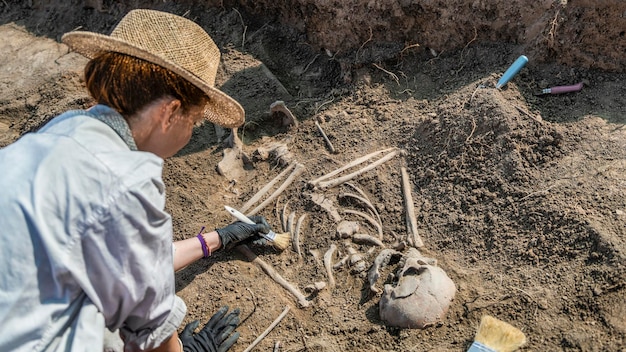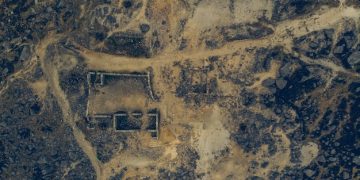Preserving America’s Archaeological Heritage: Understanding Federal Laws and Regulations

Preserving America’s Archaeological Heritage: The Role of Federal Laws and Regulations involves a complex framework designed to protect significant archaeological sites. These laws and regulations ensure the responsible management and preservation of irreplaceable cultural resources across the United States.
Archaeological sites in the United States hold invaluable clues to the nation’s past, offering insights into the lives of indigenous peoples, early European settlers, and the diverse cultures that have shaped the country. Preserving America’s Archaeological Heritage: The Role of Federal Laws and Regulations is crucial for understanding and protecting these non-renewable resources. But what specific measures are in place to ensure these sites are safeguarded for future generations? How effective are these regulations in the face of modern challenges like development and looting?
Understanding the Significance of Archaeological Heritage
Archaeological sites are more than just collections of artifacts; they are tangible links to our nation’s history. These sites provide unique opportunities to study past cultures, understand human behavior, and learn from the successes and failures of previous societies. The preservation of these sites is essential for maintaining cultural identity and fostering a sense of shared history.
Why Archaeological Sites Matter
Archaeological sites are essential to enrich our understanding of the past.
- Cultural Identity: Archaeological sites offer insights into past cultures and the evolution of human societies.
- Historical Understanding: They provide tangible evidence that complements written records, contributing to a more comprehensive historical narrative.
- Education and Research: The study of archaeological sites supports scientific research, educational programs, and cultural tourism.
Moreover, archaeological sites play a vital role in shaping our understanding of human history and cultural development. By studying these sites, archaeologists can reconstruct past environments, understand social structures, and trace the movement of people and ideas across time.

Preserving these sites ensures future generations have opportunities to learn from and appreciate the rich tapestry of human history. Without proper preservation, these invaluable cultural resources could be lost forever, depriving us of the knowledge and insights they hold.
Key Federal Laws Protecting Archaeological Sites
Several federal laws play a critical role in Preserving America’s Archaeological Heritage: The Role of Federal Laws and Regulations. These laws establish a framework for identifying, evaluating, and protecting archaeological resources on federal and tribal lands. Understanding these statutes is essential for anyone involved in development projects, land management, or archaeological research.
The National Historic Preservation Act (NHPA)
The NHPA is a cornerstone of historic preservation efforts across the United States.
- Section 106 Review: Requires federal agencies to consider the effects of their projects on historic properties, including archaeological sites.
- National Register of Historic Places: Establishes a listing of significant historic and archaeological sites worthy of preservation.
- State Historic Preservation Offices (SHPOs): Creates state-level offices responsible for historic preservation activities.
The NHPA mandates a systematic review process for all federal undertakings that could potentially impact historic properties, thus ensuring that preservation considerations are integrated into federal decision-making.
Archaeological Resources Protection Act (ARPA)
ARPA protects archaeological resources on federal and tribal lands from looting and vandalism. This act strengthens efforts for Preserving America’s Archaeological Heritage: The Role of Federal Laws and Regulations by establishing penalties for illegal excavation and trafficking of artifacts. ARPA also:
- Prohibits Unauthorized Excavation: Makes it illegal to excavate or remove archaeological resources without a permit.
- Establishes Penalties: Imposes fines and imprisonment for violations of the act.
- Encourages Cooperation: Promotes collaboration between federal agencies, tribes, and private landowners to protect archaeological sites.
ARPA plays a crucial role in deterring looting and protecting archaeological sites from damage or destruction. By providing a legal framework for prosecuting offenders, the act helps preserve these irreplaceable resources for future study and appreciation.
Native American Graves Protection and Repatriation Act (NAGRPA)
NAGPRA addresses the rights of Native American tribes and their descendants concerning the treatment, repatriation, and disposition of Native American human remains, funerary objects, sacred objects, and objects of cultural patrimony. Specifically, NAGPRA also:
- Mandates Consultation: Requires federal agencies and museums to consult with tribes regarding the disposition of cultural items.
- Establishes Repatriation Procedures: Provides a legal framework for the return of cultural items to their rightful owners.
- Protects Burial Sites: Strengthens protections for Native American burial sites on federal and tribal lands.
NAGPRA reflects a commitment to respecting Native American cultural heritage and promoting reconciliation. By giving tribes a greater voice in the management of their cultural resources, the act helps to heal past injustices and foster a more equitable relationship between the federal government and tribal nations.
The Role of Federal Agencies in Archaeological Preservation
Federal agencies play a pivotal role in Preserving America’s Archaeological Heritage: The Role of Federal Laws and Regulations. Several agencies are responsible for managing archaeological resources on federal lands, conducting archaeological research, and enforcing preservation laws and regulations. Coordinating these efforts is essential for ensuring consistency and effectiveness in preservation efforts.
National Park Service (NPS)
The National Park Service manages national parks and historic sites across the country.
- Resource Management: Oversees the protection and management of archaeological resources within national parks.
- Research and Interpretation: Conducts archaeological research and develops interpretive programs to educate the public about the past.
- Law Enforcement: Enforces preservation laws and regulations, including ARPA and NAGPRA, within national park boundaries.
Bureau of Land Management (BLM)
The Bureau of Land Management manages vast tracts of public lands, which often contain significant archaeological resources. Key responsibilities of the BLM include:
- Resource Inventory: Conducts surveys and inventories to identify and evaluate archaeological sites on BLM-managed lands.
- Permitting and Compliance: Issues permits for archaeological research and ensures compliance with preservation laws and regulations.
- Partnerships: Collaborates with tribes, state agencies, and other stakeholders to protect archaeological resources.

Coordinating these efforts among different federal agencies is essential for ensuring consistent and effective preservation practices. By working together, these agencies can leverage their resources and expertise to protect archaeological sites and promote a greater understanding of America’s past within Preserving America’s Archaeological Heritage: The Role of Federal Laws and Regulations.
Challenges in Preserving Archaeological Heritage
Despite the robust legal framework for Preserving America’s Archaeological Heritage: The Role of Federal Laws and Regulations, several challenges persist. Development pressures, looting, climate change, and insufficient funding all threaten archaeological resources across the country. Addressing these challenges requires innovative solutions and a renewed commitment to preservation.
Development Pressures
Development pressures pose a significant threat to archaeological sites, especially in rapidly growing areas. Urban sprawl, infrastructure projects, and resource extraction can lead to the destruction or disturbance of archaeological resources if proper mitigation measures are not implemented. Some effects of development are:
- Habitat Destruction: Construction activities can destroy or damage archaeological sites.
- Lack of Awareness: Developers may not be aware of the presence of archaeological resources on their property.
- Inadequate Mitigation: Mitigation measures may not be sufficient to protect archaeological sites from the impacts of development.
Looting and Vandalism
Looting and vandalism remain persistent threats to archaeological sites, particularly in remote areas. Illegal excavation and artifact trafficking can cause irreparable damage to archaeological resources and deprive researchers and the public of valuable information. To combat these threats, solutions require:
- Increased Enforcement: Strengthened law enforcement efforts to deter looting and vandalism.
- Public Education: Educational programs to raise awareness about the importance of archaeological preservation.
- Community Involvement: Engaging local communities in preservation efforts to foster a sense of stewardship.
Climate Change
Climate change is an emerging threat with potentially devastating consequences. Rising sea levels, increased erosion, and more frequent extreme weather events can damage or destroy archaeological sites, especially those located in coastal areas or fragile environments. It is important that we:
- Climate Adaptation Strategies: Develop strategies to protect archaeological sites from the impacts of climate change.
- Site Monitoring: Monitor vulnerable sites to assess the extent of damage and implement adaptive measures.
- Data Preservation: Preserve archaeological data and collections to ensure that information is not lost due to site destruction.
Future Directions in Archaeological Preservation
As we look to the future, several promising developments offer the potential to enhance efforts for Preserving America’s Archaeological Heritage: The Role of Federal Laws and Regulations. Technological advancements, community engagement, and interdisciplinary collaboration are all contributing to a more comprehensive and effective approach to preservation. These advancements can change:
Technological Advancements
Technological advancements are transforming archaeological research and preservation.
- Remote Sensing: Technologies like LiDAR and drone imagery allow archaeologists to identify and map archaeological sites more efficiently.
- Geographic Information Systems (GIS): GIS software enables archaeologists to analyze spatial data and develop predictive models for site location.
- Digital Documentation: 3D scanning and virtual reality technologies allow archaeologists to create detailed digital records of archaeological sites and artifacts.
Community Engagement
Engaging local communities in preservation efforts is essential for fostering a sense of stewardship and ensuring the long-term protection of archaeological resources. Community involvement can:
- Educational Programs: Offer educational programs to raise awareness about the importance of archaeological preservation.
- Volunteer Opportunities: Provide opportunities for community members to participate in archaeological research and preservation projects.
- Partnerships: Collaborate with local organizations and stakeholders to develop and implement preservation strategies.
Interdisciplinary Collaboration
Addressing the complex challenges of archaeological preservation requires interdisciplinary collaboration between archaeologists, historians, architects, engineers, and other professionals. Synergies can:
- Integrated Approaches: Adopting integrated approaches that consider the cultural, historical, and environmental context of archaeological sites.
- Knowledge Sharing: Sharing knowledge and expertise across disciplinary boundaries to develop more effective preservation strategies.
- Policy Coordination: Coordinating policies and regulations across different levels of government to ensure a consistent and comprehensive approach to preservation.
| Key Point | Brief Description |
|---|---|
| 🏛️ NHPA | Requires federal agencies to consider effects on historic properties. |
| 🛡️ ARPA | Protects archaeological resources from looting and vandalism. |
| 🤝 NAGPRA | Addresses the rights of Native American tribes regarding cultural items. |
| 🌍 Climate Change | Threatens archaeological sites through erosion and extreme weather. |
Frequently Asked Questions
The main goal is to safeguard significant archaeological sites and cultural resources for future generations, ensuring their responsible management and preservation.
The NHPA requires federal agencies to consider the effects of their projects on historic properties, including archaeological sites. It also establishes the National Register of Historic Places.
ARPA protects archaeological resources on federal and tribal lands from looting and vandalism by prohibiting unauthorized excavation and establishing penalties for violations.
NAGPRA addresses the rights of Native American tribes concerning the treatment and repatriation of Native American human remains, funerary objects, and sacred items.
Challenges include development pressures, looting and vandalism, climate change, and insufficient funding, all of which threaten archaeological sites across the country.
Conclusion
Preserving America’s Archaeological Heritage: The Role of Federal Laws and Regulations is essential for protecting and understanding the nation’s rich history. The legal framework established by laws like NHPA, ARPA, and NAGPRA, along with the efforts of federal agencies and community engagement, plays a crucial role in safeguarding these irreplaceable resources.





